The ability to operate in tight congested areas is a requirement in modern soccer; the best players find a way to create space/time for themselves even when under heavy pressure from opponents – this ability to create / find space + time must be coached in various scenarios.
The term ‘1v1’ is used many times to describe a situation where an Attacker is running head-on at a Defender with the aim of dribbling towards space / the goal. This, however, is only one aspect of 1v1: there are 1v1 situations with pressure / opponent in front, pressure from the side, pressure from behind. The reality is during the game many times a player must receive a pass with an opponent behind or to the side – players must learn to find space/time in this situation!
The following activities emphasize the components of ‘Receiving + Turning’ under various degrees of pressure from behind / side. Players must learn to become comfortable in possession + receiving passes even when under pressure.
The warm-up phase begins in an un-opposed situation in order for players to understand the movements + various body positions to successfully receive passes. The activities finally progress to a fully competitive 2v2 situation.
*In the coming weeks we will share ideas on developing 1v1 Domination with opponent in front.
Download / Copy Session:
1.
Setup:
Players organised in groups of 6; Players (A) act as Servers, Players (B) are positioned centrally next to two Mannequins as shown; Players (C) wait to rotate into the activity.
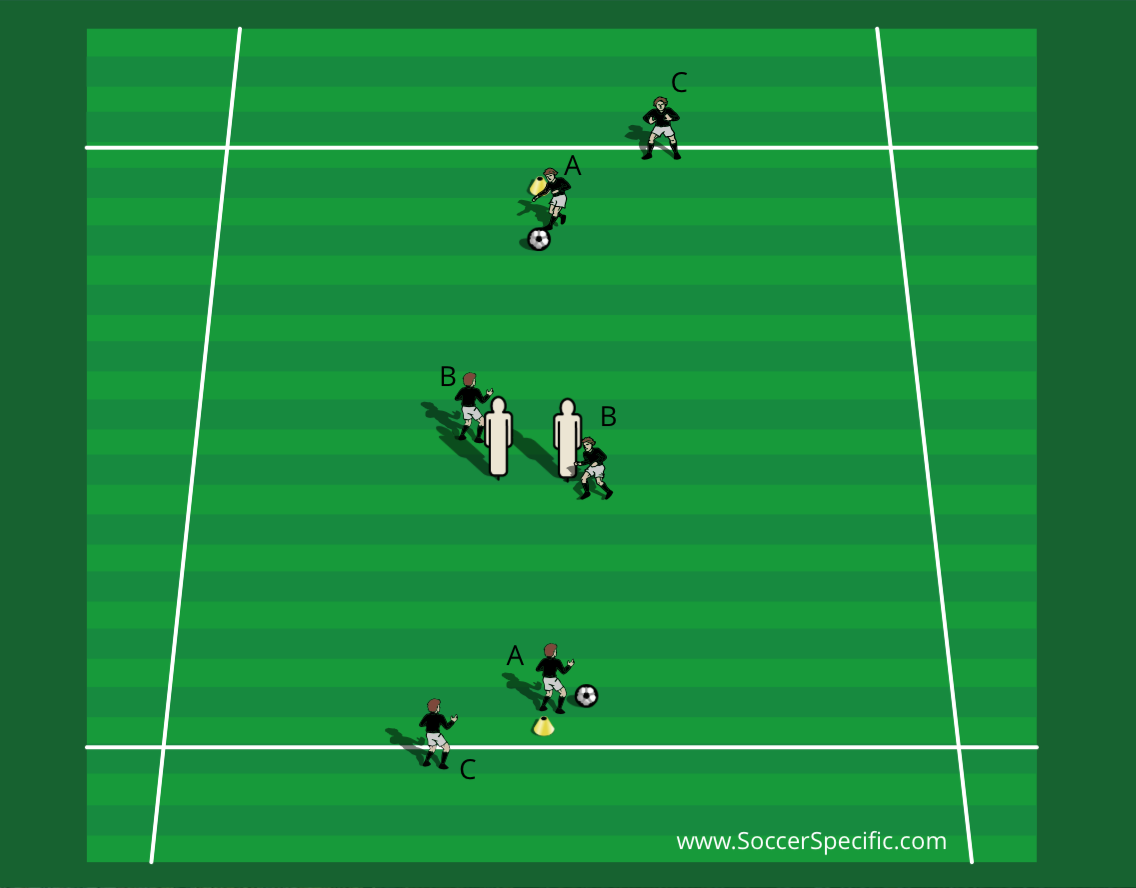
Instructions:
Player (B) must move diagonally away from the Defender (mannequin) to receive a pass from Server (A); on receiving the pass Player (B) must pass to the opposite Player (A).
Play is continuous for 30sec-1min then rotate central / Server positions.
Coaching Points:
- Receiving Player:
- Move at angles – no straight lines
- Receive in half-turned body position
- Verbal / non-Verbal communication with Server
- Opposite movement: check away then towards the ball.
- Passing Player:
- Moment / Direction / Speed of pass
2.
Setup:
Players organised in groups of 6; Players (A) act as Servers, Players (B) are positioned centrally next to two Mannequins as shown. Players (C) wait to rotate into the activity.
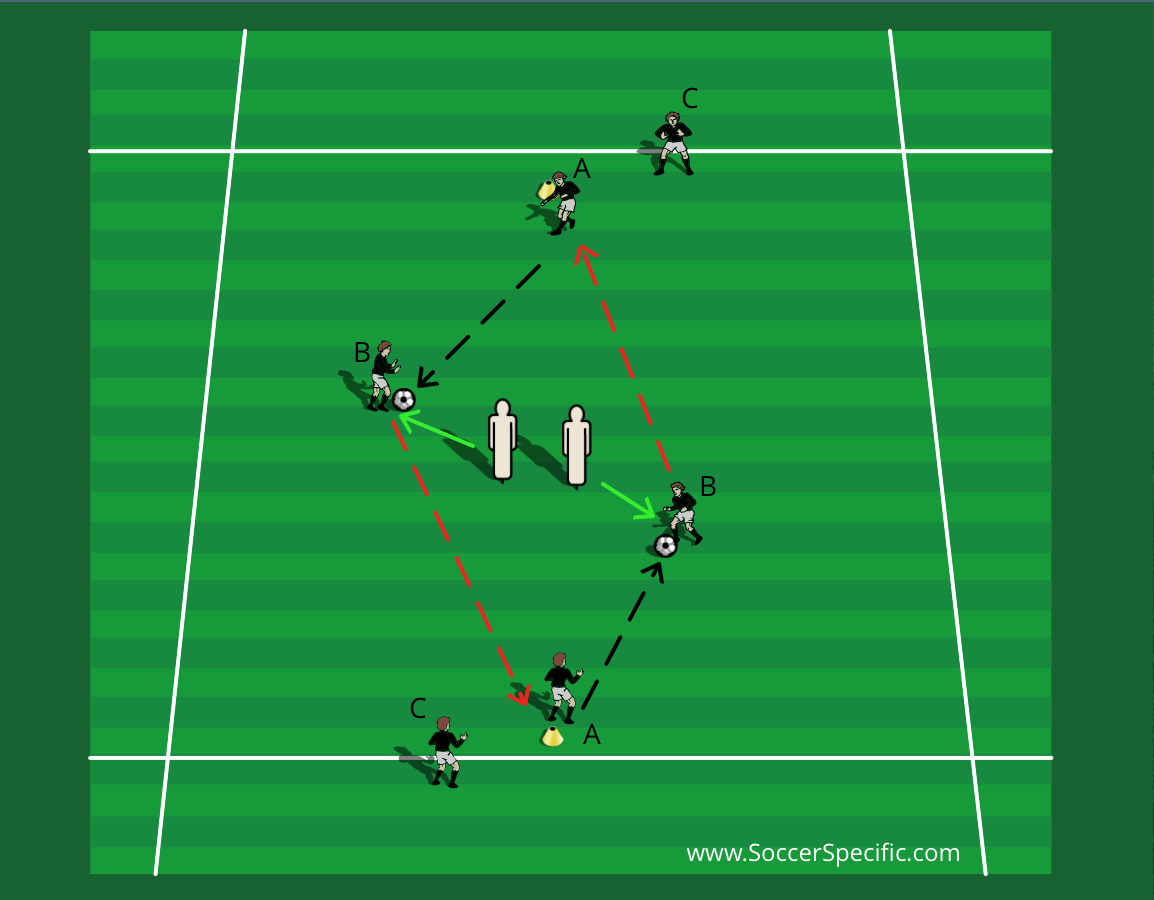
Instructions:
Player (B) has moved diagonally to receive the pass; he has received in a half-turned position which enables a quick turn forward.
Players (B) can move to either side of the Mannequin to receive the pass.
Play is continuous for 30sec – 1min then rotate the central players.
Coaching Points:
- Receiving Player:
- Move at angles – no straight lines
- Receive in half-turned body position
- Verbal / non-Verbal communication with Server
- Opposite movement: check away then towards the ball.
- Passing Player:
- Moment / Direction / Speed of pass
3.
Setup:
Players organised in groups of 6; Two groups of 3 Players as shown.
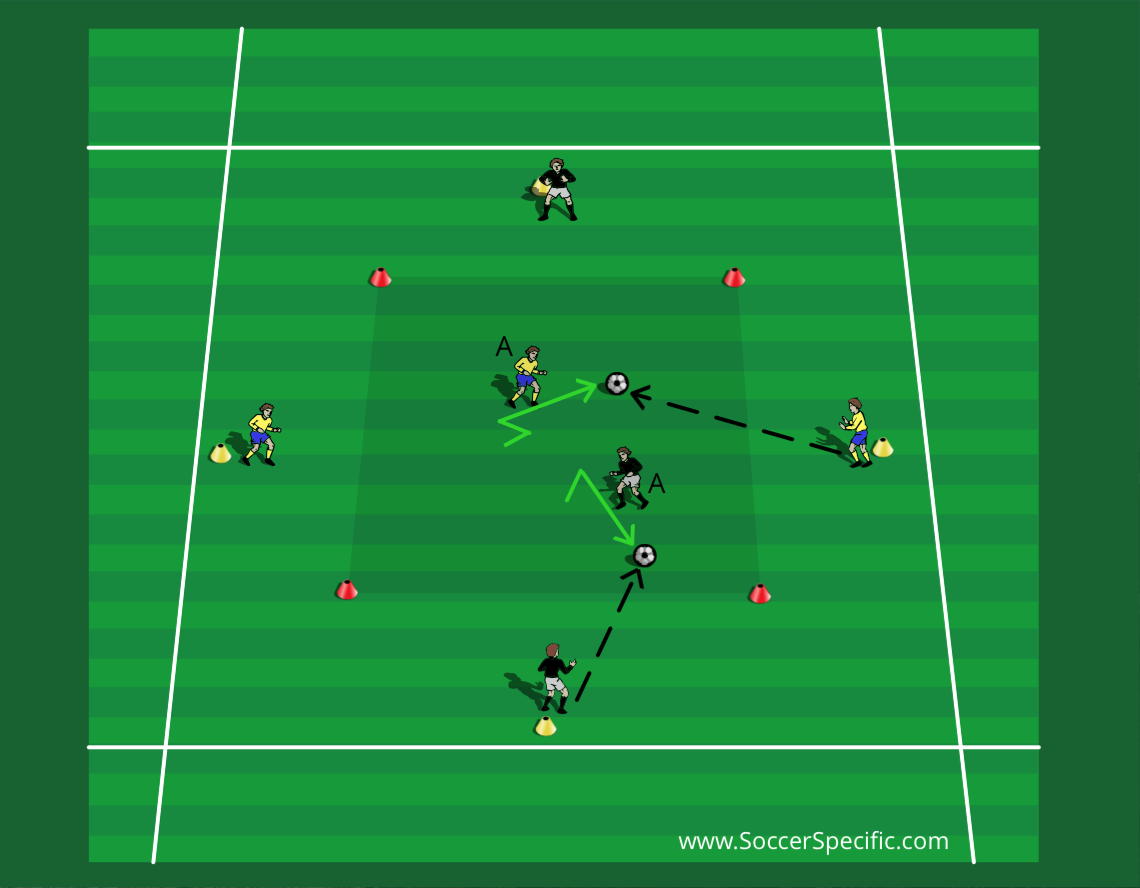
Instructions:
Progression:
Players (A) move freely in the central (shaded) area; Players (A) must move to receive passes from the perimeter players / turn quickly + pass to the opposite perimeter teammate.
The presence of the other central (A) player forces players to check for space and to better co-ordinate the timing / direction of their movements to receive passes.
Play is continuous for 45sec-1min then rotate central / Server positions.
Coaching Points:
- Receiving Player:
- Move at angles – no straight lines
- Receive in half-turned body position
- Verbal / non-Verbal communication with Server
- Opposite movement: check away then towards the ball.
- Passing Player:
- Moment / Direction / Speed of pass
4.
Setup:
Players organised in groups of 6 – two Target players (T) at each end of the grid 4 Players centrally; Two players (A) designated as Receivers.
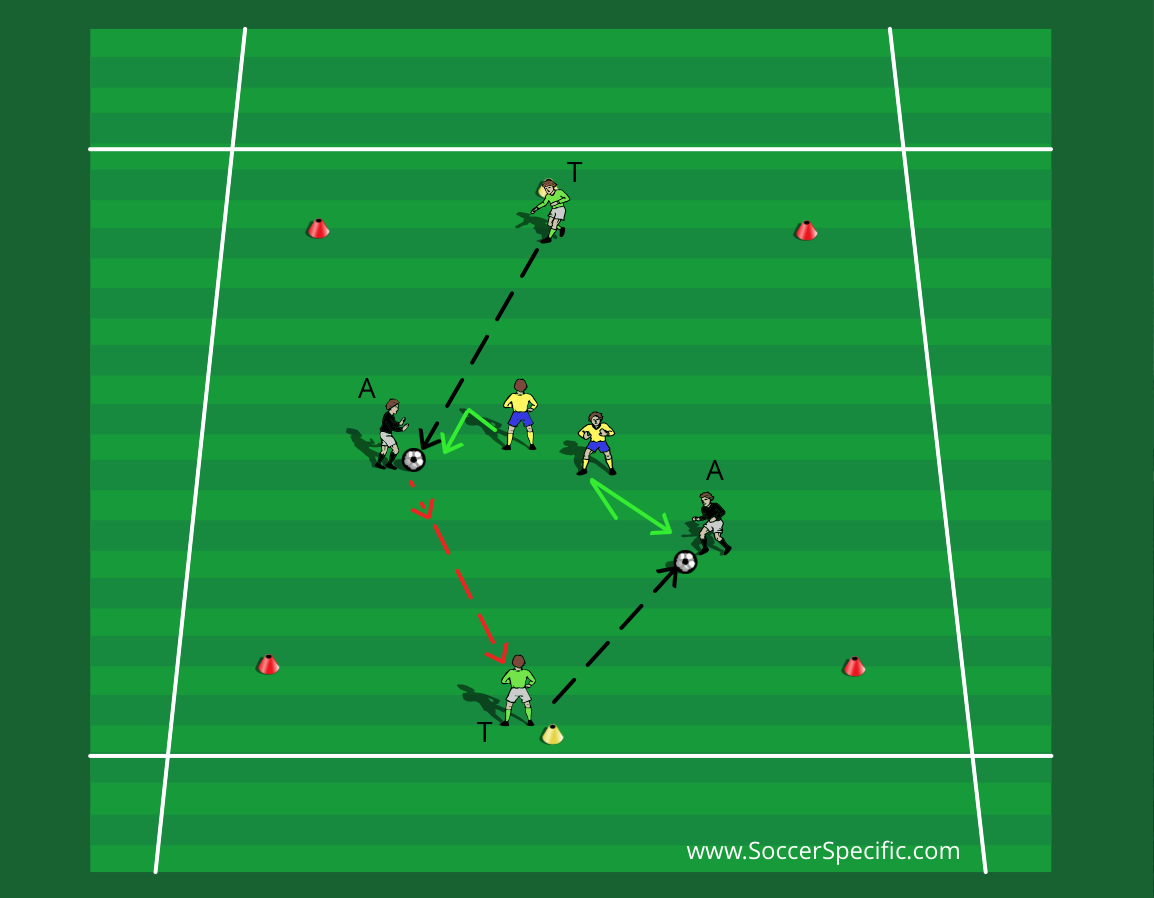
Instructions:
Progression:
Players (A) must move to receive passes from the Target players – emphasis is on receiving / turning / passing under various degrees of pressure from the opponent. The Defenders (Yellow) are instructed to offer semi-passive pressure at the beginning as well as vary their movements – tight pressure at times, back away at times; allow the Receiver to ‘feel’ various degrees of pressure.
Play is continuous for 45sec-1min then rotate central / Target positions.
Coaching Points:
- Receiving Player:
- ‘Feel’ the pressure – time to turn? Pass back one-touch?
- Move at angles – no straight lines
- Moment / Direction / Speed of movements are now crucial.
- Receive in half-turned body position if possible.
- Use of disguise / feints / various turning techniques to avoid opponent.
- Verbal / non-Verbal communication with Server
- Opposite movement: check away then towards the ball.
- Passing Player:
- Moment / Direction / Speed of pass
5.
Setup:
Players organised in groups of 6 – two Target players (T) at each end of the grid and 2v2 centrally.
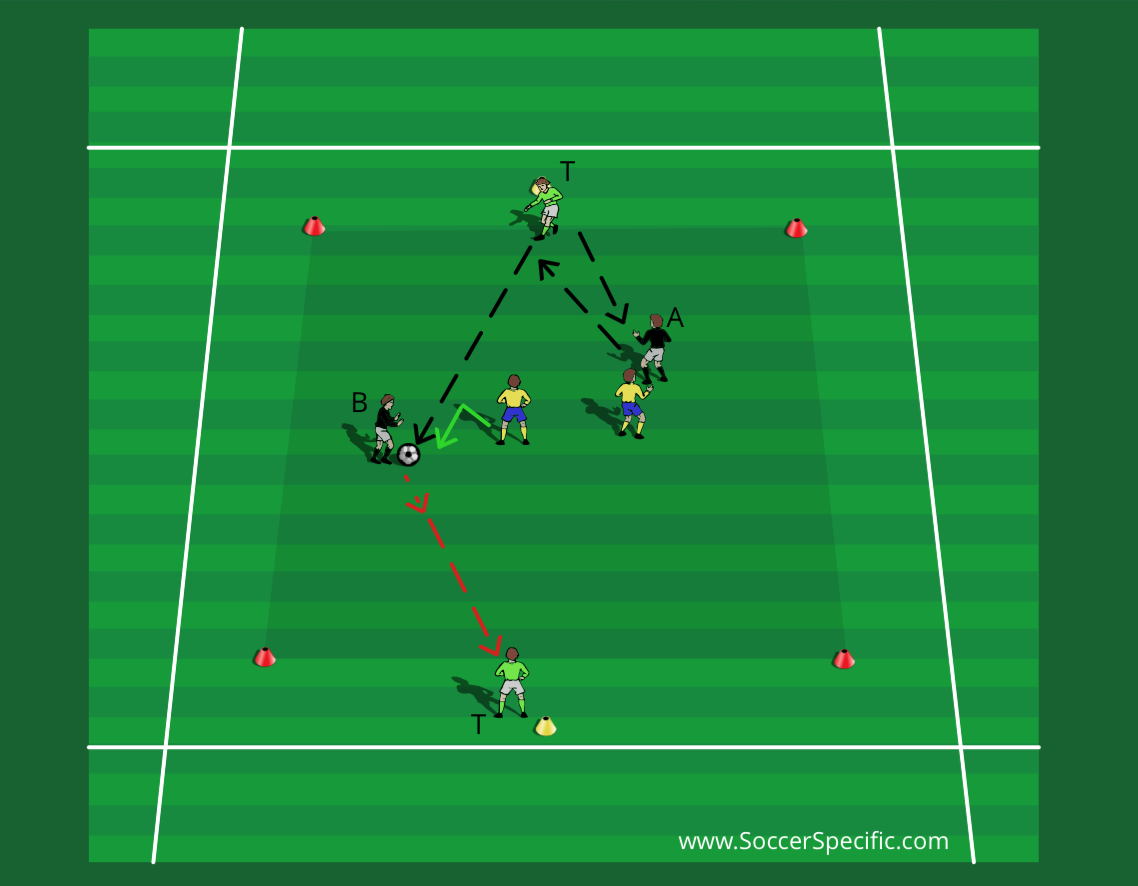
Instructions:
Progression:
Players compete centrally in a 2v2 scenario; emphasis is on receiving / turning in congested areas using various techniques.
Example: in the Diagram, Player (A) cannot turn due to pressure from the Defender; Player (A) decides to pass back to the Target player; Immediately Player (B) pulls off the shoulder of his Defender to receive a diagonal pass to feet – this enables a quick turn into space.
Play is continuous for 45sec-1min then rotate central / Target positions.
Coaching Points:
- Receiving Player:
- ‘Feel’ the pressure – time to turn? Pass back one-touch?
- Move at angles – no straight lines
- Moment / Direction / Speed of movements are now crucial.
- Receive in half-turned body position if possible.
- Use of disguise / feints / various turning techniques to avoid opponent.
- Verbal / non-Verbal communication with Server
- Opposite movement: check away then towards the ball.
- Passing Player:
- Moment / Direction / Speed of pass
